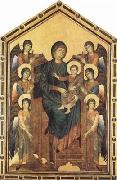
Oil On
Canvas, Real Flavor of Old Masters
|
Cimabue
|
|||
|
|
|||
| Italian b1240 - d1302 Cimabue Location Italian painter and mosaicist. His nickname means either bull-head or possibly one who crushes the views of others (It. cimare: top, shear, blunt), an interpretation matching the tradition in commentaries on Dante that he was not merely proud of his work but contemptuous of criticism. Filippo Villani and Vasari assigned him the name Giovanni, but this has no historical foundation. He may be considered the most dramatic of those artists influenced by contemporary Byzantine painting through which antique qualities were introduced into Italian work in the late 13th century. His interest in Classical Roman drapery techniques and in the spatial and dramatic achievements of such contemporary sculptors as Nicola Pisano, however, distinguishes him from other leading members of this movement. As a result of his influence on such younger artists as Duccio and Giotto, the forceful qualities of his work and its openness to a wide range of sources, Cimabue appears to have had a direct personal influence on the subsequent course of Florentine, Tuscan and possibly Roman painting. | |||
|
|
|||
|
|
Maesta (mk08) new6/Cimabue-295428.jpg Painting ID:: 21141 Visit European Gallery |
c.1270 Tempera on wood.427x280cm Paris,Musee National du Louvre | |
Height Width |
INS/CM |
||
|
X |
|
||
|
|
|||







